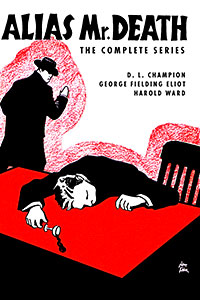 Mr. Death is a very early, but lesser-known pulp hero. Altus Press‘ volume “Alias Mr. Death: The Complete Series” collects all the original stories, plus some additional stories.
Mr. Death is a very early, but lesser-known pulp hero. Altus Press‘ volume “Alias Mr. Death: The Complete Series” collects all the original stories, plus some additional stories.
First is the serialized novel “Alias Mr. Death,” written by D.L. Champion and published under the house pseudonym of G. Wayman Jones in Thrilling Detective February 1932 through October 1932. This was published when the only pulp hero at the time was The Shadow. In some ways, it set down some of the tone of Thrilling’s Phantom Detective, which would come out in 1933, and first written by Champion also under the Jones byline.
In this nine-part novel, we met young man-about-town James Quincy Gilmore. His father is slain by the vicious Murder Club, led by nine unknown individuals. Gilmore swears vengeance on them as Mr. Death, and in the nine parts, goes after and kills each of the nine, leaving a calling card saying “Alias Mr. Death.” In the last story, after eliminating Number One, Mr. Death “kills” himself in a plane crash.
Reading this story today, one would assume it to be highly derivative, as we see many things that are commonplace today. But we need to keep in mind that this was written before these things became commonplace: Gilmore swears vengeance. He pretends to be a petty playboy to throw off suspicion. He goes about with a hood and cloak, and the like.
Each chapter is about 20 pages and a fast read. While you can guess how some things will play out (I figured out who Number One of the Murder Club was in the first chapter), some things turn out a little different from how you expect. There are a few problems with the story. At first Gilmore is sloppy about hiding his face, before he adopts a hood and cloak like the members of the Murder Club. Then, later on it’s said out of the blue that his hood is different from the Murder Clubs’ by having a white outline around the eyeholes. Then, in the last story, his hood has a small white skull above the right temple! Also, strangely enough, he gives away his identity in the last story to the police, making him a marked man. But as he killed himself, I guess that’s okay.
The book contains three further stories.
First off are two additional Mr. Death stories, written 1939 for Thrilling Detective by George Fielding Eliot. Clearly they were part of a attempted revival of the character. Some changes were made. Obviously, Mr. Death had survived the plane crash. They gave him a scar that goes up from his left eyebrow, and throbs in the presence of evil (shades of Harry Potter!). And he now wears a domino mask instead of a hood. He has apparently decided to come out of retirement, as Mr. Death is needed. But there are other changes. Forgotten is the fact that Mr. Death had revealed his identity to police in the previous story. He is now a master of disguise, and apparently has other hideouts and drives a special car, which he didn’t before. So they have made an attempt to turn him into a more standard pulp hero like the Phantom Detective.
The final story is also titled “Alias Mr. Death” but was written by Harold Ward. Ward is probably best know as the author of Doctor Death in 1935. This story was one that Ward tried to sell in 1933, and was returned unsold in 1937. It was found among his papers. While it appears to be written about a possible Mr. Death revival, the character is much different from the James Gilmore/Mr. Death. As noted in the forward to this story, it’s more like Ward’s Doctor Death, where Ward took a previous villain character from Dell and revamped it into a new Doctor Death.
A final note: Some have commented about the cover of the Altus Press edition, saying it’s kind of plan and boring. Actually, it’s the cover from the hardcover of the original “Alias Mr. Death” novel, done in 1932 by Fiction Legion. I really wish this had been pointed out, because it’s not noted in the book itself.
But check out this fun, early pulp hero novel.




Your comments